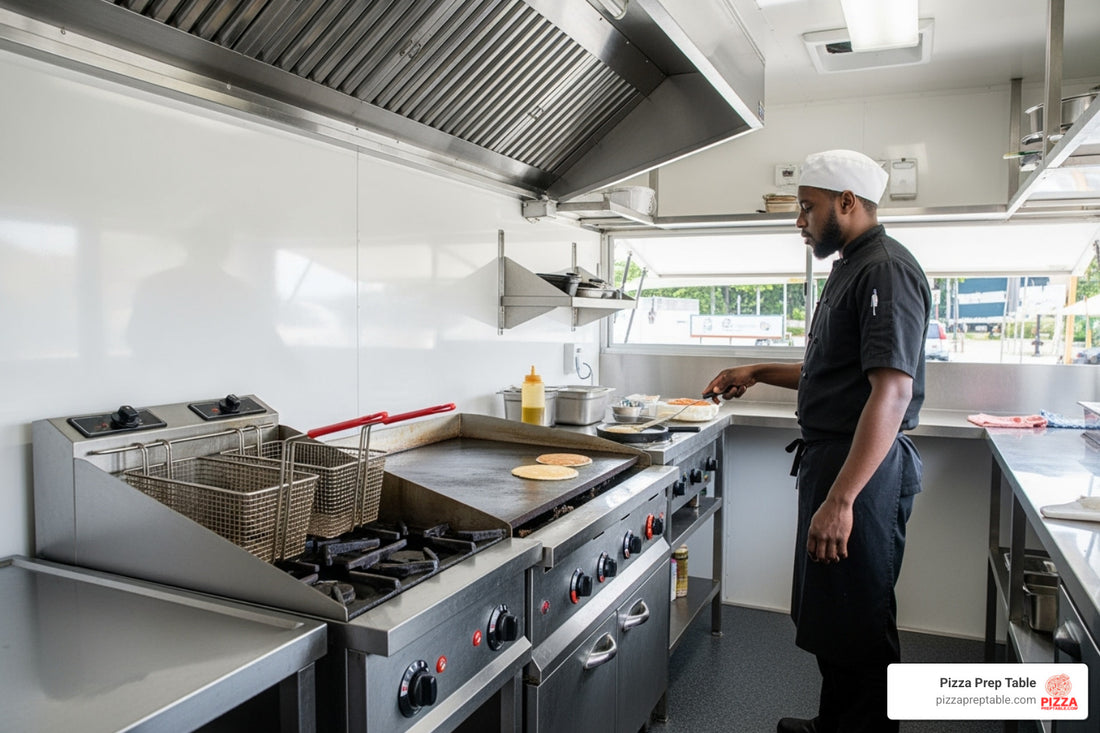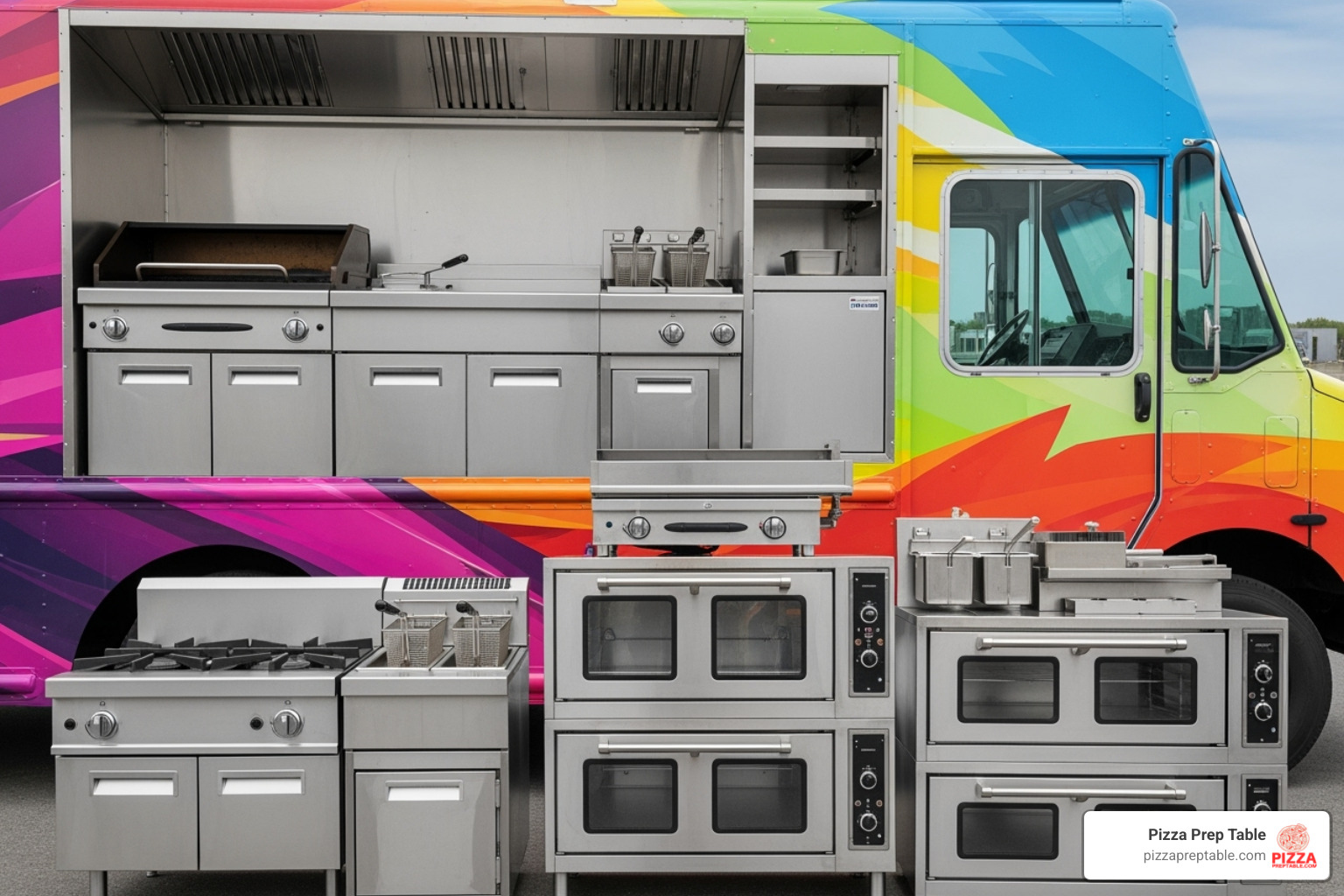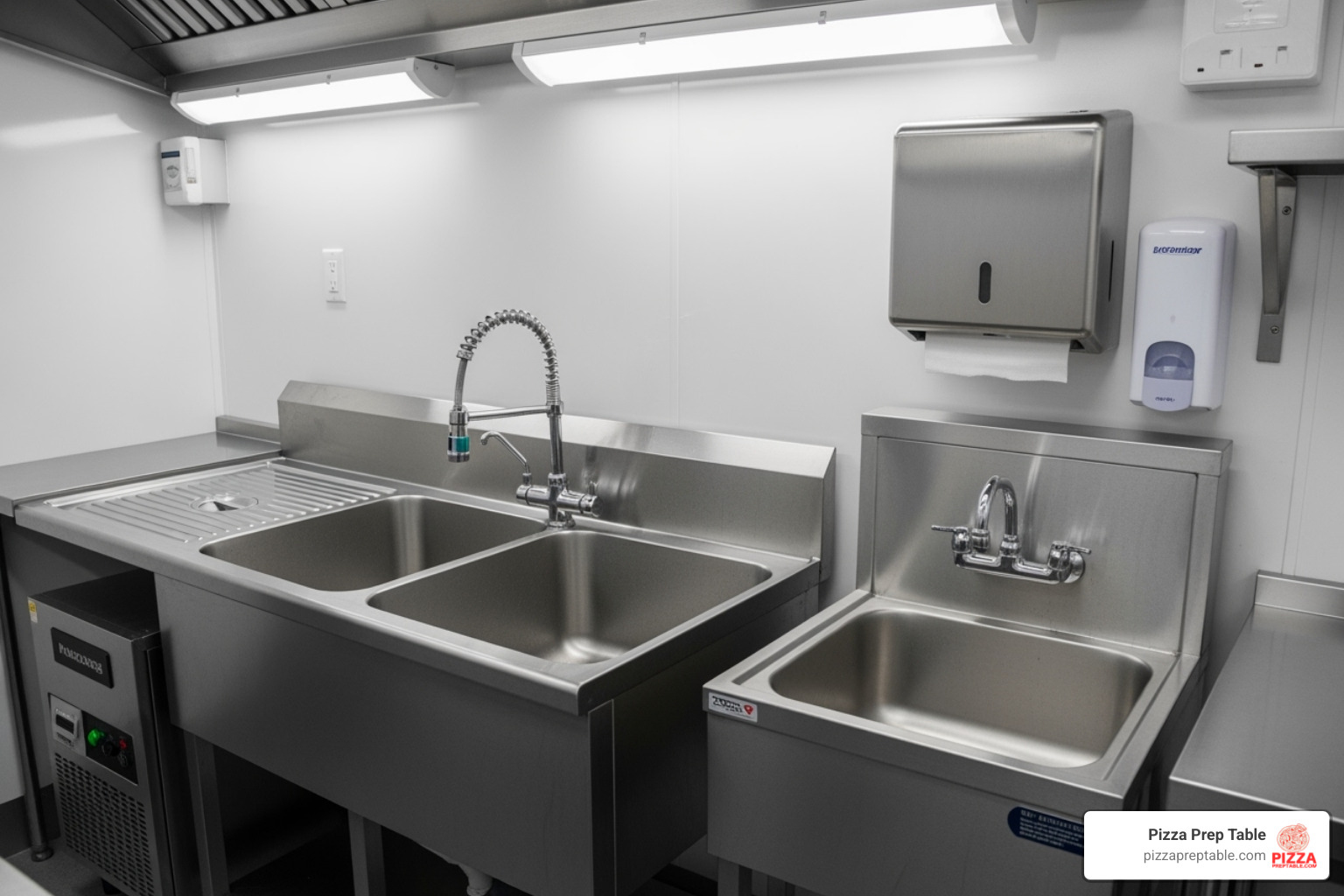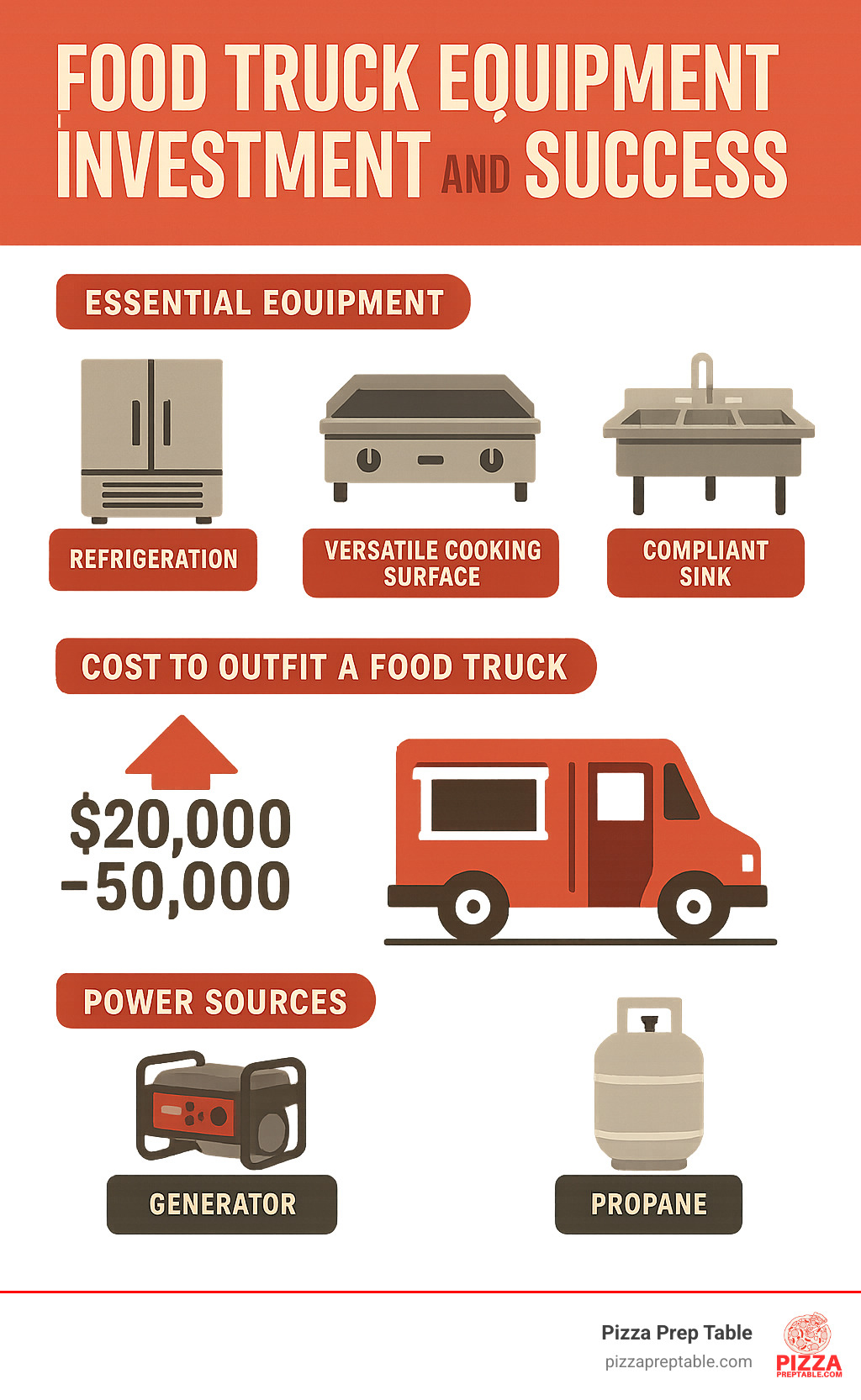
The Best Food Truck Equipment for Beginners
Share
Why Food Truck Equipment is the Foundation of Your Mobile Success
The Heart of the Kitchen: Essential Cooking Equipment
When you step into a food truck's compact kitchen, you're looking at the beating heart of the operation. Every piece of cooking equipment has earned its place through careful consideration of space, power, and menu requirements. This isn't just about having the right tools - it's about maximizing every square inch while delivering consistent, delicious food.
Griddles and flat-top grills are the true champions of mobile kitchens. These versatile workhorses can handle breakfast pancakes at dawn, lunch burgers at noon, and dinner vegetables at dusk. The beauty of a griddle lies in its simplicity - one flat, evenly heated surface that's incredibly easy to clean. You'll typically invest between $1,000-$3,000 for a quality unit, but the menu flexibility you gain is priceless.
Commercial ranges bring restaurant-quality cooking power to your mobile kitchen. With multiple burners at your disposal, you can orchestrate complex dishes while maintaining precise temperature control. One burner sautés onions while another simmers your signature sauce - that's the kind of multitasking that keeps customers happy and orders flowing.
For that unmistakable grilled flavor, charbroilers deliver the real deal. Those beautiful grill marks aren't just for show - they signal authentic barbecue taste that customers crave. Whether you're grilling chicken, steaks, or seasonal vegetables, a charbroiler adds that smoky flavor profile that's impossible to fake.
Deep fryers open up a world of crispy possibilities. Crispy Profits Await with These Food Truck Deep Fryers - and trust me, they're not wrong. From golden french fries to crispy chicken tenders, a quality fryer becomes your ticket to some of the most popular food truck items. Expect to invest $500-$2,000 for a commercial-grade unit that can handle the lunch rush.
Convection ovens are space-saving marvels that punch above their weight. These compact units circulate hot air for faster, more even cooking than traditional ovens. They're perfect for baking, roasting, and reheating while using less energy - a win-win in the mobile food world.
Don't overlook microwaves - they're the unsung heroes of efficient service. A commercial-grade microwave quickly reheats sides, steams vegetables, and handles those last-minute touches that keep service moving smoothly during busy periods.
Food truck exhaust hoods aren't glamorous, but they're absolutely essential. These systems remove heat, smoke, and odors while keeping you compliant with local fire codes. Think of them as your kitchen's respiratory system - not optional, but vital for safe operation.
When choosing between propane and electric equipment, consider your priorities. Propane offers precise heat control, lower operating costs, and freedom from electrical limitations. Electric equipment might be easier to install but demands more generator capacity - something to factor into your power planning.
Crucial Warming and Holding Equipment
Food safety isn't negotiable, and that's where warming and holding equipment becomes your best friend. Hot foods must stay at 140°F or above - not just for regulations, but for your customers' safety and your business reputation.
Food warmers are your insurance policy against the lunch rush. They keep prepared items at safe temperatures while preserving the quality and taste that brings customers back. During peak hours, these units let you prepare items in advance without sacrificing food safety.
Heat lamps provide targeted warming for specific items like those perfectly crispy fries or completed orders awaiting pickup. They're particularly valuable for maintaining food quality when orders start stacking up during your busiest times.
Fry dump stations deserve special mention for their ability to keep french fries warm and crispy after cooking. These specialized warmers use infrared heat to maintain that perfect texture without overcooking - because nobody wants soggy fries.
Soup kettles ensure your liquid-based offerings stay hot and ready to serve. Whether it's chili, soup, or stew, these units maintain consistent serving temperatures throughout your entire service day.
Proper warming and holding equipment isn't just about convenience - it's about protecting your customers and your reputation. Maintaining proper temperatures prevents foodborne illness while preserving the quality that keeps people coming back for more.
What is the best cooking food truck equipment for my menu?
Here's the truth: your menu should drive your equipment choices, not the other way around. Different food concepts have different cooking requirements, and understanding these needs upfront saves money and headaches later.
For burgers and breakfast items, a quality griddle becomes non-negotiable. The flat surface provides even heat distribution for consistent results, whether you're cooking eggs, bacon, or burger patties. It's the foundation of classic American food truck fare.
For fried foods, invest in a reliable fryer system. Top Countertop Deep Fryers for Restaurants and Food Trucks can guide you toward the right model for your volume and space constraints.
For tacos and Mexican cuisine, combine a griddle for proteins with a steam table for warming tortillas and holding prepared items. This combination provides the versatility needed for complex assembly-style dishes where timing is everything.
For pizza operations, consider compact conveyor ovens or deck ovens designed for mobile use. The unique requirements of mobile pizza operations demand specialized equipment that can handle high-temperature cooking in a confined space.
The versatility of a commercial range makes it valuable for almost any menu concept. With multiple burners and often an oven below, ranges provide the flexibility to adapt your menu as your business grows and evolves.
A quality grill or griddle averages $1,000-$3,000, while a commercial fryer typically costs $500-$2,000. These investments form the foundation of your mobile kitchen, so choose wisely based on your specific menu requirements. The right food truck equipment isn't just about cooking food - it's about building a profitable, sustainable business.
Keeping It Cool: Refrigeration and Storage Solutions

In a food-truck kitchen, dependable refrigeration is non-negotiable. Equipment must hold safe temperatures while surviving constant vibration and limited space.
Undercounter refrigerators and freezers slide beneath prep counters, giving you grab-and-go access without sacrificing floor space. Worktop refrigerators add a stainless prep surface on top of the cold storage you already need—a true two-for-one.
For rapid service, sandwich/salad and pizza prep tables keep ingredients at 41 °F or below while organizing them for lightning-fast assembly.
Glass-door merchandisers chill drinks and encourage impulse buys, and a dedicated ice maker (about $1,000-$3,000) covers beverages, storage, and display.
Most mobile operators spend $1,000-$3,000 per refrigeration unit, but that investment is tiny compared with product loss or a failed inspection.
Maximizing Space with Smart Storage
Vertical thinking is the secret to tiny kitchens. Install wall-mounted dry-storage shelves and utensil racks, and standardize on clear, food-safe containers with proper labels so staff can find ingredients at a glance. An organized truck moves faster, wastes less, and passes inspection with ease.
Prep, Serve, & Succeed: Smallwares and Service Essentials
Behind every sizzling order are the quiet performers that chop, mix, and package your food.
Stainless-steel prep tables ($200-$1,000) give you a durable, easy-sanitize work zone. Color-coded cutting boards and sharp knives prevent cross-contamination and speed through prep. Add stackable mixing bowls plus heavy-duty whisks, spatulas, and tongs—buy commercial-grade once and you won’t be shopping again in three months.
A compact food processor or blender broadens your menu without adding labor, while instant-read and probe thermometers safeguard both quality and safety.
Need specialized accessories? The team at Pizza Prep Table can point you toward gear that survives the bumps of life on the road.
Essential Disposables and Serving Supplies
Never let flimsy inventory force an early close. Stock take-out containers, trays, cutlery, napkins, condiment bottles, portion cups, and drink cups in sizes that match your menu. Modern POS systems or a simple QR-code ordering and payment setup speed service and capture sales data you can use to refine operations.
Staying Compliant: Sanitation and Safety Equipment

Let's talk about the equipment that keeps health inspectors happy and your customers safe. This isn't the glamorous stuff that makes food, but it's absolutely essential for keeping your doors open and your reputation intact.
The three-compartment sink is your dishwashing headquarters and completely non-negotiable. Health departments require these sinks for the wash-rinse-sanitize cycle that keeps your dishes and utensils properly clean. Each compartment has a specific job: washing with hot soapy water, rinsing with clean water, and sanitizing with approved chemicals. These sinks must be properly sized according to local health codes and connected to both your fresh water supply and grey water system. Expect to invest $500-$2,000, but consider it insurance for staying in business.
Your handwashing sink must be completely separate from food prep and dishwashing areas. Health inspectors are sticklers about this - you cannot wash your hands where you wash lettuce or scrub pots. This dedicated station prevents cross-contamination and ensures your team can maintain proper hygiene throughout service.
Behind the scenes, your water heater works overtime to provide the hot water required for proper sanitation. Commercial units ensure you have consistent hot water for both cleaning dishes and food preparation, even during your busiest periods.
The fresh and grey water tanks are your mobile kitchen's lifeline to proper sanitation. Fresh water tanks supply clean water for cooking and cleaning, while grey water tanks collect all that wastewater for proper disposal. These systems must be properly maintained and regularly serviced to meet health department requirements.
Anti-fatigue floor mats serve double duty by keeping your team comfortable during long service periods while meeting health code requirements for non-slip surfaces. After standing for hours on a moving vehicle, these mats are a blessing for your feet and your safety record.
Stock up on sanitizing chemicals approved by your local health department. These aren't suggestions - they're requirements for proper cleaning and disinfection. Keep plenty on hand because running out means you can't properly clean, and that means you can't legally serve food.
Multiple trash cans and liners keep waste management organized and sanitary. You'll need separate containers for different types of waste, and proper liners prevent leaks and odors that can create health hazards.
If you're running fryers, Keep Calm and Store On: Food Truck Fryer Oil Storage Tips provides crucial guidance on safely handling and storing used cooking oil. This isn't just about compliance - it's about protecting the environment and avoiding costly disposal violations.
Mandatory Safety Systems
Fire safety equipment isn't optional in commercial kitchens, especially mobile ones where escape routes are limited. Fire suppression systems are required by most jurisdictions for mobile food service operations. These automated systems detect and suppress fires in cooking areas faster than any human could react, protecting your equipment, your livelihood, and potentially your life.
Class K fire extinguishers are specifically designed for the types of fires that happen in commercial kitchens - those involving oils and fats that water would only spread around. These specialized extinguishers must be easily accessible and properly maintained. At $50-$150 each, they're some of the most affordable insurance you can buy.
Keep a fully stocked first-aid kit easily accessible but away from food preparation areas. Kitchen accidents happen, from minor cuts to burns, and being prepared protects everyone who works in or visits your mobile kitchen.
Meeting local fire codes isn't just about passing inspection - it's about protecting everything you've worked to build. The cost of proper safety equipment is minimal compared to the potential consequences of a fire or serious accident. Your insurance company will thank you, your employees will feel safer, and you'll sleep better knowing you've done everything right.
This food truck equipment might not be as exciting as a new griddle or fryer, but it's what keeps you legal, safe, and in business for the long haul.
Smart Investments: How to Choose Your Equipment
Making the right equipment calls up-front saves thousands later. Buying new means warranties, financing, and the latest tech, but costs more. Used gear slashes the ticket price and is often available immediately, yet lacks a safety net. Many operators split the difference: new for critical items like refrigeration and cooking equipment, used for non-essential or backup pieces. For a second opinion, check the overview from Taxfyle.
Key Factors for Your Food Truck Equipment
- Space & workflow – Lay out the truck so food travels logically from prep to cook to service.
- Energy – Propane usually costs less and offers better heat control; electric demands generator capacity but can simplify installation.
- Durability – All-stainless construction withstands vibration and daily cleaning.
- Ease of cleaning – Smooth surfaces and removable parts speed end-of-day sanitation.
Understanding Costs and Regulations
Major equipment becomes a capital asset you depreciate; smallwares and disposables are operating costs. Set aside a maintenance fund—mobile kitchens shake, rattle, and roll. Finally, study local health and fire codes before buying; sink size, hood type, or clearance rules vary by city and ignoring them can turn a bargain into scrap.
Pizza Prep Table not only stocks mobile-friendly refrigeration and pizza prep tables, we also offer financing that keeps your working capital free for marketing and payroll.
Frequently Asked Questions about Food Truck Equipment
What is the most essential piece of equipment for a food truck?
The exact answer depends on your menu, but three items top almost every list:
- Reliable refrigeration – keeps product safe and prevents spoilage.
- A versatile griddle – handles everything from eggs to burgers.
- A three-compartment sink system – required by health codes and therefore non-negotiable.
How much does it cost to fully equip a food truck?
Plan on $20,000–$50,000 for a basic rig and up to—or beyond—$100,000 for a high-spec build with specialized ovens or all-new gear. Menu complexity, new vs. used purchases, truck size, and local regulations account for most of the spread. Financing can smooth the upfront hit.
How do I power all my food truck equipment?
Most operators pair a 7,000-watt (or larger) generator for electrical loads with propane for cooking heat. Shore power, when available, saves fuel and noise. Always total your wattage before buying equipment so you don’t overload your system.
Conclusion

Equipping a food truck is like building a full restaurant inside a parking space: every inch and every dollar must pull double duty. Choose gear that is versatile (a griddle that flips from breakfast to burgers), durable (all-stainless refrigerators that hold temp on bumpy roads) and compliant (sink systems, hoods, and fire suppression that satisfy inspectors).
Match equipment to your menu, budget for maintenance, and think long-term—the cheapest unit is costly if it fails during a lunch rush.
Ready to start planning?
Download our Food Truck Equipment Checklist (PDF)
Explore pizza prep tables and mobile-ready equipment
With the right foundation, you’ll be rolling out great food—and profits—in no time.
